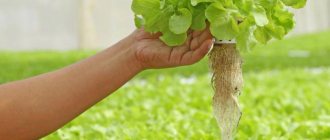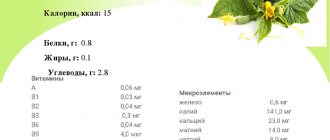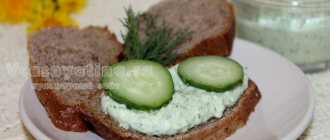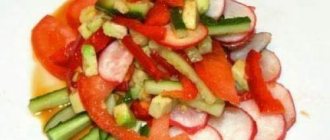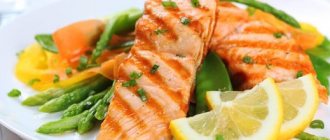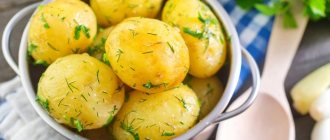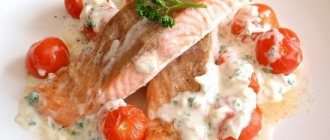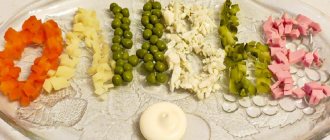Calories, kcal:
Proteins, g:
Carbohydrates, g:
Lettuce is a one- or two-year-old garden crop of the Asteraceae
. Information that lettuce was eaten is found in documents describing the existence of the ancient Roman Empire; before that time, lettuce was grown for its seeds, from which oil was squeezed out. The exact geographical place of origin of the first types of lettuce has not been historically established.
Lettuce has many varieties, the most common, leaf lettuce, has long, tender shoots in the shape of oak leaves, light green (light green) color. Lettuce leaves are juicy, crunchy, with a fresh smell, and can vary in shape and quantity located on one root or head.
Calorie content of salad
The calorie content of the salad is 12 kcal per 100 grams of product.
The salad has a rich vitamin and mineral composition, which contains: vitamins, as well as,. The product contains coarse dietary fiber, which helps improve digestion, normalizes intestinal motility, fills the volume of the stomach and, without being digested, is excreted, collecting mucus and waste from the intestinal walls. Substance lactucin
, which belongs to the group of alkaloids, not only gives the salad a bitter taste, but also actively reduces cholesterol levels in the blood. Eating lettuce leaves will help improve the condition of hair and nails, has a beneficial effect on the skin, improves memory, vision and is a preventive measure against the occurrence of Alzheimer's disease.
Despite the beneficial properties of lettuce, it can be harmful to the body.
Harm of lettuce
Reasons for reducing salad consumption are the presence of diseases such as gout, colitis and enterocolitis, urolithiasis, and hepatitis. Due to the high content of oxalic acid, the use of the product should be limited if you have kidney disease.
The salad is a unique product for those watching their weight. By eating a large bowl of lettuce leaves, you get a full stomach and a minimum of calories (calorizator). Of course, salad in its pure form does not give a feeling of fullness, so it is combined with other vegetables or protein foods. You can, without adhering to special diets, consume a portion of lettuce leaves every day for lunch or dinner, thereby ensuring regular bowel movements, healthy peristalsis and burning of fat deposits. Diets or, for example, recommend the daily use of lettuce leaves in the diet.
Selecting and storing lettuce
When choosing a salad, you need to pay attention to its appearance - the juiciness and greenness of the leaves, their elasticity, integrity and the absence of rot and dark spots. Lettuce is often sold with roots or in pots; such a product retains freshness longer, but in any case, visual inspection must be carried out carefully.
Salad in cooking
The name of the product speaks for itself; lettuce is most often used in salads. Even if it is a mixture of different types of lettuce leaves and a simple dressing from any aromatic oil -
Article read: 923
Useful properties of Iceberg lettuce, caloric content of the product and energy value
Iceberg lettuce
– an excellent option for those who adhere to the rules of proper nutrition.
The benefits of fresh greens in the human diet have been repeatedly confirmed by many nutritionists. The rich vitamin composition of the product and the low calorie content of Iceberg lettuce
provide the human body with valuable elements, and this in no way affects the figure.
In appearance, the salad resembles ordinary cabbage. It belongs to the head lettuce category. In addition to the juicy leaves enriched with vitamins, you can also eat the head of cabbage.
Popular lettuce varieties
The calorie content of lettuce (fresh) is very low, and it contains a great variety of vitamins and microelements. In addition, the bright color and beautiful shape make this product an excellent decoration for any dish. At the moment, the most popular varieties of lettuce are:
- Romaine is the leader among salads. It is a large inflorescence of several green leaves, which is somewhat reminiscent of cabbage. It is most often used in sandwiches or as a garnish.
- Watercress is one of the healthiest of its kind. It has a slight mustard taste, which can be explained by its high content of microelements. This is an excellent option to combat
- Coral gets its name from its distinctive appearance. A light nutty flavor will add an original touch to any dish. And in terms of the amount of calcium and mineral salts, this variety has surpassed all others.
Iceberg lettuce: nutritional value
Among the many varieties of green salad
Iceberg
is especially popular due to its low
calorie content
and high content of healthy elements and vitamins. The composition of this product is enriched with fiber, folic acid and many other microelements.
Many diet followers highly value Iceberg salad, which contains 100 calories
a gram of it is only 14 kcal. If we talk about energy value, then 0.1 g is fat, 0.9 g is protein and 1.8 g is carbohydrates.
Most of the composition of this green salad is water (96%). In addition, lettuce leaves contain dietary fiber, saturated fatty acids, polysaccharides, disaccharides, phytoncides, ash, and alkaloid compounds that are beneficial to the body.
Iceberg salad is also not deprived of a vitamin and mineral complex. When fresh, it contains a rich amount of retinol, ascorbic acid, B vitamins, beta-carotene, tocopherol and many others.
Among other types of greens, Iceberg is also distinguished by its capacity of vitamin K, another name for which is phylloquinone. This component stabilizes the functioning of almost all systems and organs.
The presence of minerals is also exciting, in particular phosphorus, sodium, potassium, zinc, copper, manganese, iron, selenium and others.
Given the low calorie content
and a very pleasant taste, you can eat
Iceberg salad
without any restrictions and at the same time diversify any dietary food.
The benefits of iceberg lettuce for the body
Noteworthy is not only the low calorie content of Iceberg lettuce per 100
gram of product, but also other properties that have a beneficial effect on the condition of the human body.
In particular, many nutritionists advise including these tasty greens in your diet in the following cases:
- to strengthen the cardiovascular system. The rich chemical composition has a positive effect on the body in the prevention of heart disease, atherosclerosis and strokes;
- for weight loss. The rich amount of water in the leaves, the low calorie content per 100 grams
iceberg
lettuce and the minimal amount of fat make this product ideal for those who want to correct their figure with the help of dietary nutrition; - to improve immunity. This salad culture contains elements necessary for the body such as calcium, manganese, iron and others, which provide high protection against viral, infectious and bacterial diseases;
- in the treatment of anemia. In this direction, the value of green salad lies in its high iron content;
- to normalize the functioning of the digestive system. The product significantly improves the intestinal microflora, enhances the absorption of valuable elements into the walls of the esophagus;
- to cleanse the body. Dietary fiber present in salad accelerates the removal of toxins, waste, heavy metals and radionuclides from the body;
- to strengthen muscles and bone tissue. Regular consumption of salad maintains normal water balance and promotes the rapid breakdown of formed fatty plaques.
This list of beneficial effects can be listed endlessly. Iceberg lettuce has
very low, only 13-14 kilocalories, then there is no reason to doubt its benefits.
Iceberg lettuce in cooking
The taste of Iceberg is not much different from a simple leaf lettuce. Perhaps the only difference is that when consumed it makes a peculiar crunch. The product contains only 14 kcal, which is why Iceberg lettuce is
It is considered a very popular product.
Due to their density and stability, lettuce leaves are often used in addition to preparing dishes and also for decorating them. As for the dishes themselves, there are many recipes that use not only lettuce leaves, but also heads of cabbage.
Iceberg with shrimp
Iceberg lettuce,
which is only 14 kcal, goes well with shrimp. You can prepare the dish as follows.
Combine 1 bunch of chopped lettuce with 0.5 kilos of shrimp. Add 5 boiled finely chopped eggs, a few cherry tomatoes, 200 g of white bread and 100 g of Parmesan cheese. Mix all ingredients and season with sour cream. For added spiciness, you can add black pepper and a little garlic.
This dish will decorate any holiday table with its appearance and exquisite taste.
Iceberg on the grill
A rather unusual and at the same time very tasty variation of Iceberg lettuce
, and its low
calorie content per 100
g of weight is perfect for lovers of vegetarian food.
The dish is prepared in the following order.
Cut the head of cabbage into 4 parts, leaving only the leaves. For the marinade, mix 0.5 tsp. hot sauce, 1 tbsp. l. soy sauce, 3 tbsp. l. vegetable oil and 4 g ginger root. Marinate the leaves in this mixture for 10-15 minutes. Next, mix the lemon zest with 2-5 g of hot pepper and 4 tbsp. l. sour cream. Thinly slice the onion and lightly squeeze it in vegetable oil. In another pan, fry the pickled leaves. A grill pan is perfect for this. The leaves should be browned on both sides.
Place the salad in the center of the plate, pour the remaining marinade over it and sprinkle with sesame seeds. Place sour cream sauce around the edges and sprinkle with fried onions. The finished dish is simply delicious.
Lettuce comes in several varieties, including lettuce, watercress, iceberg lettuce, arugula and many others. The low calorie content of salad with its very high nutritional value makes it an excellent dietary product. Like all green leafy vegetables, it is very healthy, containing many beneficial vitamins, minerals and amino acids and a lot of fiber. The calorie content of salad, like all green vegetables, is very low - it is not for nothing that it is included in the list of so-called “negative calorie foods”. It contains so few calories and so much fiber that it takes the body more energy to digest it than it takes in.
Calorie content of fresh leaf lettuce (lettuce) is 12 kcal per 100 g. This amount contains only 0.3 g of fat, protein content - 1.2 g, carbohydrates - 1.3 g. The main source of calories is carbohydrates and sugars.
The calorie content of fresh Iceberg lettuce is 14 kcal per 100 grams of product. Calorie content of arugula – 25 kcal per 100 g. It contains more proteins and carbohydrates and has a pleasant sour taste.
The healthiest green salad is watercress. The calorie content of this variety is 11 kcal per 100 g. It has a spicy, piquant taste due to the content of pungent substances.
The salad is not filling on its own, but is a great addition to other vegetables and foods. Low calorie content makes it an excellent option for the summer menu or fasting days. It can be used as an ingredient for other salads and side dishes, and as a decoration or a kind of substrate for other dishes - meat or fish, for example.
Harm and contraindications to eating lettuce
There are very few contraindications to lettuce, since the product, even in its raw form, is not an aggressive food for the stomach, and the content of substances that can negatively affect the course of diseases is extremely small.
You should use lettuce with caution in the following cases:
- Abuse. Do not eat too much salad, otherwise you may experience flatulence and bloating, as well as upset due to the high fiber content.
- Harmful substances. Choose your supplier carefully as this plant absorbs pesticides and toxins well. If you are not sure about the quality of the product, then you need to cut off the entire white part, leaving only the green leaves.
- Diseases of the bladder and kidneys. The content of oxalic acid can negatively affect the development and treatment of the disease.
- Increased gas formation. With such a tendency of the body, you need to eat lettuce in extremely limited quantities.
Absolute contraindications to eating lettuce:
- Urolithiasis disease. With this diagnosis, oxalic acid has a detrimental effect.
- Gastrointestinal diseases during exacerbation. It is necessary to exclude all products of plant origin, raw or fried.
- Gout. A high content of purine bases in salad is contraindicated for gout.
- Hepatitis. With this condition, the elements can cause excessive activity in the circulatory and nervous systems.
- Asthma and tuberculosis. Lettuce has the property of thinning mucus and facilitating its removal, but these diseases are of a different nature, unlike colds, so it is better to avoid the plant.
What are the benefits of salad?
In addition to its low calorie content, salad is also very healthy. It contains vitamins, microelements, amino acids, and fiber.
Vitamin A has a beneficial effect on the condition of the skin, overall well-being, improves vision and is an antioxidant that prevents the aging of the body and the formation of malignant tumors. Vitamin C, which is abundant in green salads, strengthens our immunity and increases the body's resistance to viruses and colds. B vitamins (niacin, nicotinamide, pyridoxine, folic and pantothenic acids, thiamine, riboflavin) help strengthen the nervous system, reduce stress and anxiety, and improve sleep. They improve brain function, memory, attention, relieve stress, tone up, improve blood composition, participate in the metabolic process and improve it, promote the breakdown of fats and carbohydrates for energy, normalize the acid-base balance, have an antioxidant effect, preventing the occurrence of cancer and improving the condition of our skin, teeth, hair and nails. Vitamin E contained in the leaves is also a powerful antioxidant. Vitamin K plays an important role in the process of blood clotting.
It's not just the low calorie content and high vitamin content that makes the salad so healthy. It also contains very important microelements. Calcium, phosphorus and fluorine strengthen bones and teeth. Potassium helps remove salts and excess water from the body and is necessary for the functioning of all muscles. Sodium normalizes water-salt metabolism. Magnesium and zinc are necessary for all metabolic processes in the body; in addition, magnesium, zinc and copper improve the condition of hair, nails and skin. Iron is necessary for blood, and iodine is necessary for the proper functioning of the thyroid gland. Manganese regulates blood sugar levels, has an antioxidant effect and improves liver function. Selenium slows down the aging of the body and preserves youth, beauty and vigor of a person. Lutein and zeaxanthin are extremely important for human vision, and like all polyphenols, they are also effective antioxidants. Lactucin calms the human nervous system, normalizes sleep, and also prevents salt deposition. Pectins improve intestinal function and help the body get rid of “bad” cholesterol.
Due to the low calorie content of salad and its ability to improve metabolism and stimulate the breakdown of fats, it is recommended for consumption by those who are obese. The ability to regulate blood sugar levels makes this green very beneficial for diabetics. The leaf variety is useful for mental workers and those whose work involves heavy mental and nervous stress - it stabilizes the nervous system and stimulates brain function.
Green salad is recommended for consumption by women - it helps maintain youth and beauty, relieves unpleasant symptoms of PMS, and the iron it contains prevents anemia during menstruation. It effectively fights constipation. In medicine it is used to treat peptic ulcers of the stomach and duodenum, as well as in the treatment of chronic gastritis. It improves appetite and promotes better digestion of food. Normalizes blood pressure, cleanses the blood, relieves headaches, is effective against vitamin deficiency and hypovitaminosis, and promotes tissue regeneration. It has an antimicrobial effect, improves immunity and helps the body fight various diseases, and also helps to quickly recover from illness.
Eating salad is recommended for those who want to normalize metabolism and improve blood circulation. For swelling, greens, due to their high potassium content and mild diuretic effect, remove excess fluid and salts from the body.
And don’t forget that the low calorie content of salad allows it to effectively fight excess weight.
Interesting facts about leaf lettuce
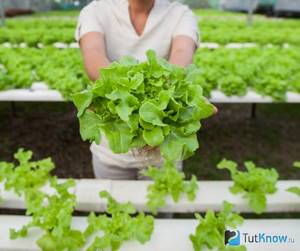
It can also be found in the CIS countries, where, as in Europe, this species is considered an inedible weed. Lettuce was introduced into the agricultural crops of the Mediterranean before our era. There are chronicle mentions of him in such ancient states as China, Greece, Rome and Egypt. In modern Europe, salad appeared in the 16th century, and in Russia - one century later.
How to prepare leaf lettuce - watch the video:
A wide selection of different varieties of seed lettuce, each of which has its own unusual taste, allows you to find exactly the right product for your dish. This plant does not need extra praise: the “track record” of useful substances speaks for itself, so without further hesitation, the salad should be included in your menu.
Calorie content of salad and weight loss
The salad seems to have been created specifically to be added to the diet during various diets. The high content of vitamins and microelements plays an extremely important role in conditions of a limited diet, and the low calorie content allows you not to overeat and comply with daily calorie restrictions.
Salad in diets should be combined with carbohydrates and proteins - meat, poultry, fish, vegetables, nuts, cheeses. You can use it as the basis of vegetable salads, combining it with tomatoes, cucumbers, bell peppers, and olives. Such dishes are best seasoned with olive oil and lemon juice, and to enhance the fat-burning effect, you can add garlic, ginger or cinnamon.
You can also arrange fasting days on salad - the low calorie content will allow you to keep your daily calorie intake within 1000 kcal, without suffering from hunger. When fasting on salad, you need to eat at least 500-700 grams of this salad and 1 kg of any other green vegetables or tomatoes. Vegetable salads can be seasoned with a spoon of olive oil and lemon juice. During the day you need to drink enough water or green tea - at least 1.5 liters. In one such fasting day, you can cleanse the intestines, remove excess fluid from the body, rid your body of toxins, and repeating such fasting days once a month will allow you to lose weight smoothly and steadily.
Popular articles Read more articles
02.12.2013
We all walk a lot during the day. Even if we have a sedentary lifestyle, we still walk - after all, we...
606440 65 More details
Vinaigrette is one of the easiest to prepare, healthy and delicious dishes, which, moreover, is quite affordable, because for…
Salads made from vegetables are invariably popular with professional chefs and ordinary housewives. All of us know that any vegetable...
for weight loss
As already mentioned, the calorie content of lettuce leaves per 100 grams. - only 16 kcal, and therefore it is simply an ideal dietary product. If you want to lose weight, then you simply need to include it in your diet, because with low energy value it contains a huge amount of useful substances. However, this product should not be the only one on your menu. If you don't eat enough protein and fat, you risk harming your health. It is more of an auxiliary product that will be an excellent addition to fish, white meat and vegetables.
- be sure to season the salad with vegetable oil or yogurt;
- To prevent the leaves from becoming bitter, soak them in water for a few minutes;
- It is better to chop greens with your hands rather than with a knife, so as not to expose the product to oxidation;
- Do not dress the salad in advance so that the leaves do not wilt and lose their taste.
One of the healthiest and most affordable spring foods is lettuce. Calorie content per 100 grams is no more than 16 kcal, regardless of the variety. In terms of the concentration of vitamins and minerals, this product can compete with many vegetables. However, this is not all the information that is useful to know about the salad. So, the following interesting facts are associated with this product:
- translated from Italian, the word “salad” means “salty”, although the taste of the product is fresh or slightly bitter;
- the darker the lettuce leaves, the more nutrients they contain;
- This culture is very demanding in terms of storage: greens cannot be dried, canned, frozen or kept in the refrigerator for a long time;
- lettuce was originally a weed until the ancient Greeks appreciated its taste and health benefits (this happened about 5,000 years ago);
- At the moment, lettuce is often found both in garden beds and in stores, but in the times of the Persian sheikhs it was worth its weight in gold;
- the modern history of lettuce leaves began when Christopher Columbus brought their seeds to America;
- from the point of view of the content of vitamins and minerals, the lower part of the leaves is of greatest value.
The benefits of salads for weight loss
Any nutritionist will tell you that anyone who wants to reduce their weight noticeably and for a long time needs to start eating healthy. And a healthy diet necessarily includes the oldest dish of world cuisine - salad. Of course, preference should be given to vegetable salads with low calorie content.
When losing weight, a vegetable salad performs several functions at once - it satisfies the feeling of hunger and fills the stomach, nourishes the body with useful microelements and vitamins, and also serves as a kind of “broom” - it cleanses the intestines and improves metabolism. As with everything, you need to approach the preparation of salads wisely and lovingly.
In spring, summer and autumn, it is advisable to choose vegetables for salad at the market, and not in the supermarket. In winter, it is better to “click” on sauerkraut with onions - a rich storehouse. Season with vegetable oil and you can safely eat a fairly large portion. Neither excess weight nor colds will bother you.
Salad in cosmetology
Lettuce leaves are useful not only for the internal systems of the body. This product helps maintain external beauty and solve a number of cosmetic problems. So, if you have dry skin, then apply a mask of sour cream with crushed green leaves twice a week.
If your skin needs intensive nutrition, it is recommended to use a product consisting of lettuce pulp, vegetable oil and lemon juice. This mask will help you cope with freckles and pigmentation. If the epidermis is too dry, you can add egg yolk.
During the cold season, the skin is prone to irritation and peeling. To eliminate these unpleasant symptoms, it is enough to wipe your face with a decoction of lettuce leaves several times a day. This remedy is also great for burns and insect bites.
In summer, skin needs protection more than ever. If you are afraid that your face or shoulders will burn, it is not at all necessary to apply a special cream. Before going outside, apply a lettuce leaf to your skin for a few minutes, after beating it with a rolling pin or crushing it in your hands.
The most of the most
If we strictly talk about calorie content, then the very, very low-calorie
and an easy-to-make fresh salad is
the lettuce salad
.
Season the chopped lettuce leaves with a sauce made from vegetable oil and vinegar, mixed in equal proportions. Chopped dill will complete the picture. The calorie content per 100 grams of this salad is only 12 kcal!
But in order to eat this salad often, you need to really love greens or have great willpower. Low-calorie salads include all salads made from non-starchy green vegetables - spinach, celery, cucumbers, radishes, cabbage. The more traditional and beloved salad of cucumbers and tomatoes is also low-calorie (if seasoned with vegetable oil, then 100 grams contains 46 kcal
). Read more about cucumber and tomato salad in a separate article.
Vinaigrette, popular in the autumn-winter period, can be called a medium-calorie salad. So, the simplest vinaigrette without beans will amount to 131 kcal per 100 grams
. look in the article about this multi-variant salad.
High-calorie salads include salads with a large number of ingredients, with vegetables containing starch, with meat, seasoned with mayonnaise or even fattier dressings. Interestingly, Caesar salad
, which many consider dietary, thanks to the dressing, it has
500 kcal per 100 grams.
It is also important that the chicken in the salad is not very fatty.
"Olivie"
, which is guilty of being high in calories, will give you only
284 kcal
.
If you replace boiled sausage with chicken breast, then only 234 kcal. Another symbol of the holiday is the salad “Herring under a fur coat” - 193 kcal per 100 grams.
Another thing is that here you need to know when to stop and even on a holiday not to eat these mayonnaise salads in bowls.
Obviously, vegetable salads should be on our menu every day. But with the onset of autumn coolness and winter cold, the body objectively requires something more nutritious. And then we recommend adding meat to salads - primarily chicken. Boiled chicken breast is a great and substantial addition to a green salad base like arugula and celery.
With low-fat yogurt, the calorie content of such a salad will not exceed 83 kcal per 100 grams. If desired, you can replace the chicken with beef. Beef salad with vegetables
It will also be low in calories (
113 kcal per 100 grams
) and very healthy. If your husband said to a vegetable salad - eat it yourself, then the whole family will be happy to eat such a nutritious salad with you for dinner.
All seafood is fantastically low in calories. If you love, know how to choose and cook, feel free to add squid, shrimp, and mussels to vegetable salads. The calorie content of such a dietary dish will not exceed 90-100 kcal per 100 grams. And, of course, from time to time you can pamper yourself and your loved ones with salads with fish - boiled, smoked, salted.
These salads cannot be called low-calorie or dietary, but they are very nutritious and rich in fatty amino acids necessary for the body. For example, red fish salad
– lightly salted salmon – with potatoes and cucumber has
254 kcal per 100 grams
. But we recommend not using chips and croutons in salads at all. These products not only add extra calories to the salad, they are a fly in the ointment that spoils the usefulness of other ingredients.
Application
Fresh lettuce leaves are often used in Mediterranean cuisine. They are added to salads, sandwiches, and decorate dishes. It is recommended to chop the salad by hand, since the substances included in its composition react with the metal of the knife and an oxidation process occurs. Lettuce leaves are used to wrap the filling. Sometimes added to soups at the very end of cooking.
Market Analytics
- 2020 in the beauty industry – innovation without borders
- Black Lives Matter movement: reaction and consequences for the beauty industry
- COVID-19 is changing the rules of the game in the cosmetics market
Convenient search for beauty salons on our website
Beauty salons in Moscow Beauty salons in St. Petersburg Beauty salons in Ekaterinburg Beauty salons in Novosibirsk
Latest blog posts on our website
- Naturecream / Tremella Extract - Snow Mushroom Detox for Skin
- Prostye-sovety / How to visually enlarge your lips with makeup
- Naturecream / Apricot kernel oil for face
- Naturecream / MATRIXYL3000 - the best skin elasticity stimulator
- Naturecream / SPF in Natural Oils
- Naturecream / Geranium (Pelargonium) oil for skin health and beauty
- Prostye-sovety / Save on a beauty salon: procedures that can be done at home
- Naturecream / Growth Factor - brings back youth?
- Oksana-Lezina / 3 effective abdominal exercises from a fitness instructor for beginners
- Prostye-sovety / Making perfect curls at home
Latest forum topics on our website
- Natalya / How to properly make a gelatin mask?
- Mrs._Smith / Badly sunburned! What to do?((
- Ice / Is it necessary to combine fitness classes with a diet?
- Antonova / What can be used for hair loss?
- Radio operatorKat / Who was on a protein diet?
Other articles in this section
| Horseradish Horseradish belongs to the cruciferous family, like radish, cabbage and mustard. The long, pointed root of the plant, which has a pungent taste and pungent aroma, is used in cooking. This vegetable crop is common in Eastern Europe and the Mediterranean. |
| Pickled capers Capers are considered a delicacy and are used as a seasoning in Italian cuisine. These are immature buds of the wild caper plant. It does not like frost and grows in Southern Europe only at above-zero temperatures. It is difficult to grow capers on purpose; they prefer places sheltered from the wind - along walls and hedges. |
| Pickled sweet peppers Pickling is a popular method of preserving peppers, which preserves up to 80% of vitamins and nutrients. Pickled peppers not only retain the benefits of fresh vegetables, they are also a source of beneficial bacteria and enzymes. |
| Yams Yams resemble sweet potatoes, but these plants have nothing in common. This vegetable plant with starchy tubers originates from West Africa, where it has been cultivated for tens of thousands of years. There are more than two hundred varieties of yam. White, yellow, Chinese yams and some other varieties are grown on an industrial scale. |
| Radicio Salad Although called lettuce, Radicio is a type of leaf chicory. It has been grown in Italy for centuries, and radicchio means “red chicory” in Italian. There are many varieties of Radicio lettuce, which are named after the city where they are grown - Radicio Treviso, Radicio Castelfranco, Radicio Chioggia, Radicio Verona. This perennial plant is similar to cabbage, with wine-red leaves with large white veins forming heads. |
| Jerusalem artichoke Jerusalem artichoke is a root crop of the sunflower genus of the Asteraceae family, native to the central regions of North America. It is sometimes called the “Jerusalem artichoke” or “earth apple”. Jerusalem artichoke tubers are round in shape and covered with brown, purple or pink skin. The average weight of a tuber is 100-200 g. The fruit pulp is white and sweetish, contains starch. In many countries of Western Europe and the Mediterranean region, Jerusalem artichoke is used in the same way as potatoes. |
| Beetroot The homeland of wild beets is located in North Africa, where they began to grow in prehistoric times. Then people ate only beet leaves, and the ancient Romans were the first to use the root crop for food. Thanks to them, beets spread throughout Europe. Beetroot became especially popular in the 19th century, when it was discovered that this vegetable could replace sugar cane in terms of sugar content. Beetroot is a beautiful red-violet root vegetable with a sweet taste. |
| Parsley (root) Parsley root resembles carrots or parsnips in appearance, but is distinguished by its light beige color. Its flavor has been described as a cross between celery, carrots, leaf parsley and turnip. It is believed that parsley root was first used in cooking in Germany in the 16th century. Since then, due to its high nutritional value, parsley root has often been added to diets in Germany, Holland and Poland. |
| Cowpea The cowpea legume is known as the green bean in Western countries. They are very similar to green beans, but have a more delicate taste. In Russia, the traditional name for cowpea is cowpea. In fact, this vegetable plant native to Central Africa is neither a bean nor a pea. Its green pods reach a length of up to one meter. Vigna is characterized by high productivity, easily tolerates long-term storage, and does not require much space in the garden plot. Cowpea is a climbing plant and requires support. |
| Boiled zucchini The closest relative of zucchini, zucchini is a common vegetable crop in central Russia. The shape of the fruit resembles a cucumber, 12-40 cm long and 5 cm in diameter. Zucchini is covered with a thin edible peel, under which delicate white pulp and soft seeds are hidden. |
Calorie table for salads
| Salad | Calories, kcal | Belkov, Mr. | Zhirov, g | Carbohydrates, g |
| Salad of tomatoes, cucumbers, peppers | 30,8 | 1 | 0,8 | 6 |
| Salad "Cabbage with Apples" | 32,4 | 1,5 | 0,2 | 6,5 |
| Cabbage salad | 67,9 | 1,8 | 3,6 | 7,6 |
| Tomato salad with garlic sauce | 71 | 3,8 | 1,8 | 10,2 |
| Apples with nuts | 75,8 | 1,7 | 0,3 | 17,6 |
| Sauerkraut with sunflower oil | 77,8 | 1,6 | 3,1 | 11,6 |
| Raw carrots and apples | 83 | 1,3 | 4,7 | 9,2 |
| Radishes seasoned with sour cream | 104 | 2,9 | 8 | 3,1 |
| Liver salad | 104,7 | 8,2 | 7,5 | 1,1 |
| Champignon salad with sour cream and egg | 143,1 | 3,9 | 12,5 | 4 |
| "Greek salad | 188,5 | 3,9 | 17,8 | 3,4 |
| Sorrel salad with onions and mayonnaise | 200,1 | 2,3 | 18,8 | 5,8 |
| "Mimosa" | 296,6 | 6,3 | 28,4 | 4,5 |
1. Super-light salad for a late dinner (
per 100 grams - 33.95 kcal B/F/U - 1.17/0.44/6.21).
Ingredients:
- 2 fresh cucumbers
- 2 raw carrots
- 2 apples
- 100 g green salad
- 1/2 cup natural yogurt
- 1/4 lemon
- salt, pepper to taste
Preparation:
Cut washed fresh cucumbers, raw carrots and apples into thin strips, and lettuce leaves into 3-4 pieces each. Mix all this and season with yogurt, adding lemon juice, salt, etc. Top the salad with sliced tomatoes.
Light cabbage salad
per 100 grams - 34.65 kcal USED - 2.14/0.57/5.61
Ingredients:
- Finely shredded cabbage 6 cups (about 1 whole head)
- Carrots 2 pcs.
- Red onion, thinly sliced 1 cup (about 1 onion)
- Natural yogurt 1 cup
- Dijon mustard 2 tbsp. l.
- Water 1 tbsp. l.
- Freshly squeezed lemon juice 2 tsp.
- Dill seeds 0.5 tsp.
- Salt and pepper to taste
Preparation:
Shred the cabbage, chop the onion, grate the carrots. Whisk yogurt, mustard, water and lemon juice in a large salad bowl. Add vegetables and dill seeds. Stir, salt and pepper to taste. The salad can be covered with a lid and refrigerated. It will be good the next day too.
Protein salad with tuna and cottage cheese
per 100 grams - 57.12 kcal USED - 9.59/1.26/1.9
Ingredients:
- 350 g grainy low-fat cottage cheese
- 1 can of tuna in its own juice
- 6 cucumbers (fresh)
- bunch of parsley
- 2 boiled egg yolks
Preparation:
Chop the parsley, peel the cucumbers and cut into slices. Mix cottage cheese, parsley and cucumbers. Drain the juice from the tuna into a bowl. Crumble the yolks there and mix until smooth. Place the salad on plates, place the tuna pieces on it, and pour the dressing over it.
Light layered salad for dinner
per 100 grams - 99.91 kcal USED - 15.57/3.56/1.27
Ingredients:
- 1 grated cucumber
- A piece of boiled chicken. breasts
- 1 tomato, peeled
- 2 eggs (a layer of white, a layer of yolk with herbs)
- 1 tbsp. lemon.juice
- 1 tsp olive oil
Preparation:
We chop everything and lay it out in layers. Drizzle juice and oil onto a layer of cucumber and tomato.
Squid salad “Lasso”: for dinner!
per 100 grams - 76.21 kcal USED - 8.91/3.21/3.31
Ingredients:
- Squid (carcass) 3 pcs.
- Carrot 1 pc.
- Cucumber 1 pc.
- Eggs 2 pcs.
- Dill to taste
- Natural yogurt 50 g
Recipes for dishes with seed lettuce
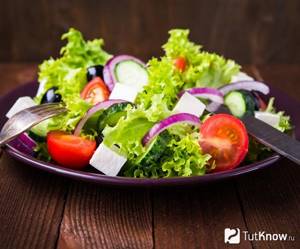
When choosing a salad, you need to pay attention to some external signs that will allow you to make the perfect dish using it:
- Stem
. It should be free of damage, yellow spots or mucus. - Leaves
. For any salad, they should be elastic and without dark spots. - Color
. It can vary from soft green to red-brownish: it all depends on the variety.
Do not underestimate the different types of seed lettuce: each of them has its own purpose in cooking.
Lettuce has a short shelf life, but the leaves are soft and tender and do not need to be finely chopped, unlike other greens, but can simply be torn into pieces of the desired size with your hands.
The salad can be used not only as a decoration for a dish due to its color, but also goes well with fried meat, fatty sauces, cheese, nuts and seafood in any form.
As an example, we present you several recipes with lettuce:
- Avocado roll
. Peel 600 grams of king prawns from dark areas and shells. Prepare the marinade: mix salt, cumin, ground black pepper, lemon juice and olive oil. Cover the shrimp evenly with the marinade and leave to steep for 15-20 minutes. Peel and remove the seeds from soft ripe avocados (2 pieces), mash the pulp with a fork. Finely chop a small bunch of cilantro, add 100 grams of thick sour cream, salt, lemon juice and ground pepper to taste, mix with avocado pulp until as smooth as possible. Cut 1 large bunch of lettuce into thin strips. Gently shake off excess spices from the marinated shrimp and fry on the grill or over hot coals. You can prepare 6 tortillas or flatbreads yourself, or you can buy ready-made ones. When buying ready-made ones, you should take either classic wheat ones or cheese flavored ones. Place the flatbreads on the grill or grill and heat them up. Roll each one up in a convenient way, add a little avocado sauce, then alternate between lettuce, shrimp and sauce. Serve immediately with warm green tea. - Three cheese salad
. Tear lettuce (200 grams) into large pieces with your hands. Cut 50 grams of mozzarella, mirabeau and robiola into small cubes or break into pieces. Cut 150 grams of baguette into cubes and dry in the oven. Cut medium gherkins (6-8 pieces) and cherry tomatoes (6-8 pieces) into arbitrary, not very small pieces. Cut sun-dried tomatoes (50 grams) into thin short strips. Place the ingredients in one cup, add 2 tablespoons white wine vinegar, 4 tablespoons olive oil, basil leaves and salt to taste. Mix with your hands or a wooden spatula. - “Light” salad
. Tear 400 grams of lettuce into large pieces by hand. Cut cheese or tofu (200 grams) into medium cubes, finely chop a bunch of dill and basil. Cut 200 grams of cherry tomatoes into halves, peel 150 grams of cucumbers, cut into arbitrary pieces. Mix all ingredients, pour in lemon juice and sprinkle with a small pinch of celery seeds.
Infrequent watering or harvesting too late can cause the lettuce to taste bitter, both in the veins with the stem and in the leaves themselves.
Due to their loose structure, most edible varieties cannot be subjected to heat treatment, as the leaves completely lose their shape. Note! If the lettuce leaves have lost some of their shape or crispness, they can be soaked in cold water to restore freshness.
